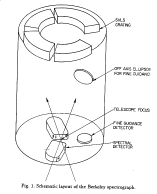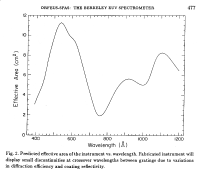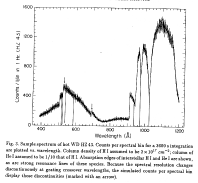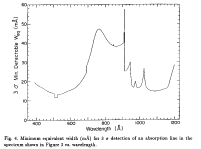|
|||||||||||||||||||
|
|
|||||||||||||||||||
|
|
ORFEUS-SPAS: THE BERKELEY EUV SPECTROMETER
STUART BOWYER
Space Astrophysics Group, Center for EUV
Astrophysics, University of California, Berkeley, California 94720
and
MARK HURWITZ
Space Astrophysics Group, Center for EUV
Astrophysics, University of California, Berkeley, California 94720
ORFEUS-SPAS, the Orbiting Retrievable Far and Extreme
Ultraviolet Spectrometers, on the Astro-SPAS space platform, is a
joint project of NASA and the BMFT in the Federal Republic of Germany
(see Kraemer et al. 1990, this volume). The Berkeley spectrograph for
this mission will obtain high-resolution ( /
/
 >
7000) spectra of point sources between 390 and 1200 Å. The
Berkeley instrument incorporates a set of four novel spherically
figured, varied line-space (SVLS) gratings used in a geometry that is
similar to that of the classic Rowland mount to span this large
wavelength interval. Two spectral detector units containing curved
NICPs and delay-line anodes encode the arriving photons in digital
format for telemetry. An additional optic directs the image of the
source in the entrance aperture onto a sealed FUV detector which is
used to track the source as it drifts during an observation, enabling
a postflight reconstruction of the spacecraft pointing vector. This in
turn will allow us to define the wavelength of each recorded photon
with precision.
>
7000) spectra of point sources between 390 and 1200 Å. The
Berkeley instrument incorporates a set of four novel spherically
figured, varied line-space (SVLS) gratings used in a geometry that is
similar to that of the classic Rowland mount to span this large
wavelength interval. Two spectral detector units containing curved
NICPs and delay-line anodes encode the arriving photons in digital
format for telemetry. An additional optic directs the image of the
source in the entrance aperture onto a sealed FUV detector which is
used to track the source as it drifts during an observation, enabling
a postflight reconstruction of the spacecraft pointing vector. This in
turn will allow us to define the wavelength of each recorded photon
with precision.
 In Figure 1 we show a schematic layout of the optical components of the
spectrograph. The instrument contains four diffraction gratings,
arranged so that each is illuminated by a "wedge" on the annular
aperture of the telescope primary mirror. Each wedge subtends about 20%
of the available geometrical area of the I rn diameter primary and
therefore has a focal ratio of about f/5 rather than the full
f/2.4 from the primary mirror. Each grating is used to study
only one-fourth of the total 390-1200 Å bandpass, and operates
over a relatively small range of diffraction angle
In Figure 1 we show a schematic layout of the optical components of the
spectrograph. The instrument contains four diffraction gratings,
arranged so that each is illuminated by a "wedge" on the annular
aperture of the telescope primary mirror. Each wedge subtends about 20%
of the available geometrical area of the I rn diameter primary and
therefore has a focal ratio of about f/5 rather than the full
f/2.4 from the primary mirror. Each grating is used to study
only one-fourth of the total 390-1200 Å bandpass, and operates
over a relatively small range of diffraction angle  , allowing high
diffraction efficiency to be maintained. Two spectral detector units
each accept the spectra from two diffraction gratings.
, allowing high
diffraction efficiency to be maintained. Two spectral detector units
each accept the spectra from two diffraction gratings.
In our design, each diffraction grating in the instrument is spherical, with a radius of curvature of 1 in. Unlike the conventional Rowland spectrograph, the groove spacing of each grating varies as a fourth order function of position on the optic. Furthermore the distances from the telescope image to the grating center, and from the grating center to the detector surface, are not equal to the values on the corresponding Rowland circle. The astigmatism and aberrations of this spectrograph are substantially lower than what would be achievable with a conventional Rowland spectrograph and toroidal, uniform line-space diffraction gratings. A more detailed description of SVLS spectrometers can be found in Harada and Kita (1980).
Two detectors are used, each accepting the dispersed spectra from two
diffraction gratings. The MCPs are spherically curved, with a radius
chosen to provide a close match to the tangential focal surface of the
diffraction gratings. A flat detector would have limited the resolution
to  1500. Each detector contains a
stack of two MCPS, the electron charge clouds from which strike a
delay-line anode readout system (Lampton, Siegmund and Raffanti
1987).
1500. Each detector contains a
stack of two MCPS, the electron charge clouds from which strike a
delay-line anode readout system (Lampton, Siegmund and Raffanti
1987).
The fine guidance system consists of a small off-axis ellipsoid,
which intercepts a fraction of the beam from the primary mirror and
images the target onto a sealed-tube MCP detector equipped with a
wedge-and-strip readout system (Martin et a]. 1981). The fine guidance
system is sensitive to photons in the 1400-1800 Å band. Each
pixel on the detector represents about 3" on the sky. To determine the
location of the source to a precision of about 1", we will place the
detector so that the image is defocused to cover  3 pixels and calculate a centroid of the photons
recorded during a given integration period. The integration period is
determined by the expected drift rate of the target in the aperture;
during one second the target should move no more than about 1". Even a
relatively faint target such as the hot WD HZ43 should produce over 100
events s-1 on the detector, enabling a centroid to be
calculated to an accuracy better than 1".
3 pixels and calculate a centroid of the photons
recorded during a given integration period. The integration period is
determined by the expected drift rate of the target in the aperture;
during one second the target should move no more than about 1". Even a
relatively faint target such as the hot WD HZ43 should produce over 100
events s-1 on the detector, enabling a centroid to be
calculated to an accuracy better than 1".
 The telescope primary mirror will be
coated with iridium, a stable coating which provides good
normal-incidence reflectivity across the instrument bandpass. The
diffraction gratings will be coated with the same material. We expect
that the gratings will achieve a groove efficiency of
The telescope primary mirror will be
coated with iridium, a stable coating which provides good
normal-incidence reflectivity across the instrument bandpass. The
diffraction gratings will be coated with the same material. We expect
that the gratings will achieve a groove efficiency of  50%, and that
the quantum detection efficiency will be equal to that measured for the
stable photocathode KBr by Siegmund et al. (1988). The resulting
curve of effective-area-versus-wavelength is shown in Figure 2.
50%, and that
the quantum detection efficiency will be equal to that measured for the
stable photocathode KBr by Siegmund et al. (1988). The resulting
curve of effective-area-versus-wavelength is shown in Figure 2.
Prior to the launch of ORFEUS in 1992, NASA will have flown two other major instruments with spectroscopic capabilities in the EUV. These are HUT (Davidsen et al. 1989) and EUVE (Malina and Bowyer 1989). Although the relative sensitivity of these instruments depends on quantities that may be difficult to estimate (e.g., the detector background rate), for relatively bright sources it is the effective area that limits the achievable signal-to-noise, so it is the effective area - and spectral resolution - that we compare here.
HUT contains a normal-incidence mirror which is only slightly smaller
than that of ORFEUS. The spectrograph design is a classical Rowland
mount. At wavelengths between 840 and 1580 Å, the HUT grating is
used in first order and should achieve a net effective area that is
 1.5 times that of ORFEUS. Between 420
and 925 Å, the HUT grating is used in second order and can achieve an
effective area roughly equal to that of ORFEUS. But because many
targets will be substantially fainter in that band than at first-order
wavelengths, an aluminum filter will certainly be needed for continuum
measurements to attenuate the first-order radiation and may well be
needed for studies of line radiation. This filter reduces the HUT
effective area at the short wavelengths to 1/6 to 1/10 that of ORFEUS,
depending on wavelength. The spectral resolution of HUT is
1.5 times that of ORFEUS. Between 420
and 925 Å, the HUT grating is used in second order and can achieve an
effective area roughly equal to that of ORFEUS. But because many
targets will be substantially fainter in that band than at first-order
wavelengths, an aluminum filter will certainly be needed for continuum
measurements to attenuate the first-order radiation and may well be
needed for studies of line radiation. This filter reduces the HUT
effective area at the short wavelengths to 1/6 to 1/10 that of ORFEUS,
depending on wavelength. The spectral resolution of HUT is
 400,
approximately 1/20 that of ORFEUS. The EUVE spectrometer overlaps the
ORFEUS bandpass below
400,
approximately 1/20 that of ORFEUS. The EUVE spectrometer overlaps the
ORFEUS bandpass below  760 Å.
Its effective area is 1/4 to 1/20
that of ORFEUS at overlap wavelengths. The resolution of the EUVE
spectrograph is about 275, roughly 1/30 that of ORFEUS.
760 Å.
Its effective area is 1/4 to 1/20
that of ORFEUS at overlap wavelengths. The resolution of the EUVE
spectrograph is about 275, roughly 1/30 that of ORFEUS.
In order to demonstrate the power of this instrument, we have simulated the spectra of a source that is a likely candidate for observation during tile ORFEUS mission: a hot WD. Because ORFEUS will provide unique data about the ISM as Nvell as the point sources themselves, we have also estimated the sensitivity of the instrument to detection of absorption line features. This is by no means an exhaustive set of sources we expect to observe, which includes stars from many regions of the H-R diagram, interacting binaries, and other celestial objects.
 In Figure 3 we show a simulated spectrum of the
hot WD HZ 43 as would be observed with this instrument. We display the
background-subtracted photon counts per spectral resolution element
versus wavelength for an integration time of 3600 s. Discontinuities in
the spectrum occur at wavelength breaks between the diffraction
gratings and also at the absorption edges of neutral hydrogen and
neutral helium. Absorption lines due to the strongest resonance
transitions of interstellar neutral hydrogen and neutral helium are
shown. These strong absorption features are detected at a high level of
significance; it is of interest to evaluate what equivalent width an
absorption feature would have that would be detected in this spectrum
at some threshold, e.g., 3
In Figure 3 we show a simulated spectrum of the
hot WD HZ 43 as would be observed with this instrument. We display the
background-subtracted photon counts per spectral resolution element
versus wavelength for an integration time of 3600 s. Discontinuities in
the spectrum occur at wavelength breaks between the diffraction
gratings and also at the absorption edges of neutral hydrogen and
neutral helium. Absorption lines due to the strongest resonance
transitions of interstellar neutral hydrogen and neutral helium are
shown. These strong absorption features are detected at a high level of
significance; it is of interest to evaluate what equivalent width an
absorption feature would have that would be detected in this spectrum
at some threshold, e.g., 3  significance.
significance.
 We
show this minimum detectable equivalent width in Figure 4. Given the
measured column density of HI towards HZ 43, we expect to detect line
features of many elements in a variety of ionization states, greatly
improving our understanding of the LISM. Although only a few sources
are expected to be as EUV-bright as HZ43, with longer integration times
it will be possible to perform similar studies on a variety of WD
targets.
We
show this minimum detectable equivalent width in Figure 4. Given the
measured column density of HI towards HZ 43, we expect to detect line
features of many elements in a variety of ionization states, greatly
improving our understanding of the LISM. Although only a few sources
are expected to be as EUV-bright as HZ43, with longer integration times
it will be possible to perform similar studies on a variety of WD
targets.
This research was supported in part by NASA grant NGR-003-460.
Davidsen, A.F., Kimble, R.A., Durrance, S.T., Bowers, C.W., and Long, K.S.: 1989, R. F. Malina and S. Bowyer (eds.), Extreme Ultraviolet Astronomy, New York: Pergamon Press
Harada, T. and Kita, T.: 1980, Appl. Opt 19, (23), 3987
Kraemer et al.: 1990, This volume, pp. 177-184
Lampton, M., Siegmund, O.H.W., and Raffanti, R.: 1987, Rev. Sci. Instrum. 58, (12), 2298
Malina, R.F. and Bowyer, S.: 1989, R. F. Malina and S. Bowyer (eds.), Extreme Ultraviolet Astronomy, New York: Pergamon Press
Martin, C., Jelinsky, P., Lampton, M., Malina, R.F., and Anger, H.O.: 1981, Rev. &i. Instrum. 52, (7), 1067
Siegmund, O.H.W., Everman, E., Vallerga, J.V., and Lampton, M.: 1988, Appl. Opt. 27, (8), 1568
Taken from Observatories in Earth Orbit and Beyond, ed. Y. Kondo pp. 475-480, 1990 published by (Kluwer Academic Publishers) and reprinted here with permission of the authors and the publishers.
|
|
|




 Follow Us
Follow Us